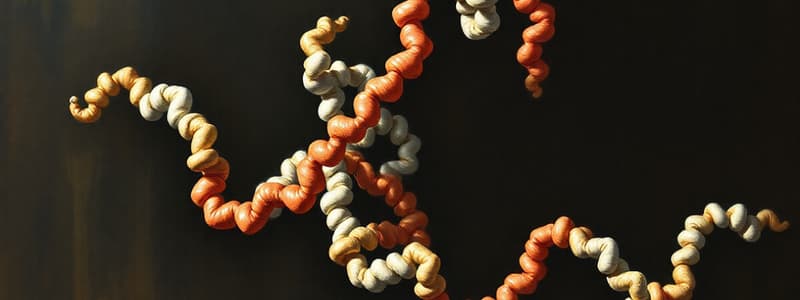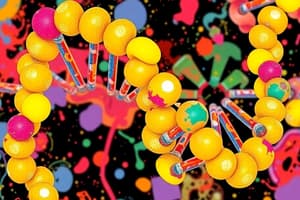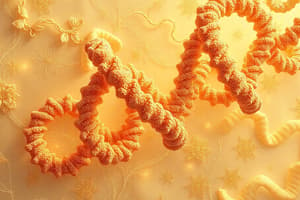Podcast
Questions and Answers
What is the primary feature of amyloid structures in relation to normally soluble proteins?
What is the primary feature of amyloid structures in relation to normally soluble proteins?
- They enhance the correct folding of proteins.
- They convert to insoluble fibrils rich in β sheets. (correct)
- They maintain their soluble state.
- They replicate the activity of correctly folded proteins.
Which best describes the biochemical activities of the chemokine structure compared to the β-sheet structure?
Which best describes the biochemical activities of the chemokine structure compared to the β-sheet structure?
- They share similar receptor activation mechanisms.
- Both bind to glycosaminoglycan simultaneously.
- Both structures are equally stable.
- They cannot perform their specific activities simultaneously. (correct)
What role does the heme group play in hemoglobin's function?
What role does the heme group play in hemoglobin's function?
- It aids in the breakdown of carbon dioxide.
- It facilitates the binding and transport of oxygen. (correct)
- It stabilizes the structure of hemoglobin.
- It contributes to the iron metabolism of cells.
How does the stability of correctly folded proteins compare to their incorrectly folded counterparts based on the content?
How does the stability of correctly folded proteins compare to their incorrectly folded counterparts based on the content?
What characterizes the structure of hemoglobin in terms of its subunits?
What characterizes the structure of hemoglobin in terms of its subunits?
What is the main function of hydrogen bonds in the alpha helix structure?
What is the main function of hydrogen bonds in the alpha helix structure?
Which statement accurately describes beta-sheets?
Which statement accurately describes beta-sheets?
What is the primary characteristic of reverse turns in polypeptide chains?
What is the primary characteristic of reverse turns in polypeptide chains?
What role do disulfide bonds play in the stabilization of protein structures?
What role do disulfide bonds play in the stabilization of protein structures?
Which of the following best characterizes cysteine knots in proteins?
Which of the following best characterizes cysteine knots in proteins?
What effect do cysteine knots have on proteins?
What effect do cysteine knots have on proteins?
When discussing loops in polypeptide chains, their size can affect what aspect?
When discussing loops in polypeptide chains, their size can affect what aspect?
In beta-sheets, how are adjacent β-strands held together?
In beta-sheets, how are adjacent β-strands held together?
What differentiates the α-helix from a β-strand in terms of structure?
What differentiates the α-helix from a β-strand in terms of structure?
What characterizes inherently unstructured proteins (IUPs)?
What characterizes inherently unstructured proteins (IUPs)?
Which statement accurately describes metamorphic proteins?
Which statement accurately describes metamorphic proteins?
What is an amyloid fibril?
What is an amyloid fibril?
Which property is unique to lymphotactin?
Which property is unique to lymphotactin?
How do alternative conformations of a peptide sequence influence protein folding?
How do alternative conformations of a peptide sequence influence protein folding?
What occurs to a protein during denaturation when exposed to 8 M urea and β-mercaptoethanol?
What occurs to a protein during denaturation when exposed to 8 M urea and β-mercaptoethanol?
Which of these diseases is classified as an amyloidosis?
Which of these diseases is classified as an amyloidosis?
Why are disulfide bonds crucial in protein structure?
Why are disulfide bonds crucial in protein structure?
What role do chemokines like lymphotactin play in the immune system?
What role do chemokines like lymphotactin play in the immune system?
What phenomenon describes the change in hemoglobin's structure upon ligand binding?
What phenomenon describes the change in hemoglobin's structure upon ligand binding?
What best describes the profile of a folding funnel in protein folding thermodynamics?
What best describes the profile of a folding funnel in protein folding thermodynamics?
What does the concerted model of hemoglobin suggest about the T and R states?
What does the concerted model of hemoglobin suggest about the T and R states?
What determines the conformation of a peptide?
What determines the conformation of a peptide?
In the renaturation process, what role does β-mercaptoethanol play?
In the renaturation process, what role does β-mercaptoethanol play?
Which statement most accurately describes the behavior of hemoglobin as it binds oxygen?
Which statement most accurately describes the behavior of hemoglobin as it binds oxygen?
Which statement correctly describes the native conformation of a protein?
Which statement correctly describes the native conformation of a protein?
Which structure is primarily associated with risk factors for amyloidosis?
Which structure is primarily associated with risk factors for amyloidosis?
Which of the following sequences is noted in the structural context of proteins?
Which of the following sequences is noted in the structural context of proteins?
What is the primary significance of the 15-degree rotation of the αβ dimers in hemoglobin?
What is the primary significance of the 15-degree rotation of the αβ dimers in hemoglobin?
What function does β-mercaptoethanol serve in protein folding?
What function does β-mercaptoethanol serve in protein folding?
What represents the state of a protein at the top of the folding funnel?
What represents the state of a protein at the top of the folding funnel?
Under which conditions does the T state of hemoglobin predominantly exist?
Under which conditions does the T state of hemoglobin predominantly exist?
What is the result of removing urea while retaining a trace of β-mercaptoethanol during the renaturation process?
What is the result of removing urea while retaining a trace of β-mercaptoethanol during the renaturation process?
What is the effect of oxygen binding on the affinity of hemoglobin for additional oxygen?
What is the effect of oxygen binding on the affinity of hemoglobin for additional oxygen?
What is the relationship between hemoglobin's R state and its oxygen affinity?
What is the relationship between hemoglobin's R state and its oxygen affinity?
What occurs to the protein's enzymatic activity during the denaturation process?
What occurs to the protein's enzymatic activity during the denaturation process?
Flashcards
Hemoglobin T state
Hemoglobin T state
The low-affinity state of hemoglobin, less likely to bind oxygen
Hemoglobin R state
Hemoglobin R state
The high-affinity state of hemoglobin, more likely to bind oxygen
Oxygen binding to hemoglobin
Oxygen binding to hemoglobin
The process where oxygen molecules attach to hemoglobin, changing its shape and affinity
Concerted model
Concerted model
Signup and view all the flashcards
Cooperativity
Cooperativity
Signup and view all the flashcards
T-to-R transition
T-to-R transition
Signup and view all the flashcards
Sigmoidal binding curve
Sigmoidal binding curve
Signup and view all the flashcards
Secondary Structure of Proteins
Secondary Structure of Proteins
Signup and view all the flashcards
Alpha Helix
Alpha Helix
Signup and view all the flashcards
Beta Sheet
Beta Sheet
Signup and view all the flashcards
Disulfide Bond
Disulfide Bond
Signup and view all the flashcards
Reverse Turn
Reverse Turn
Signup and view all the flashcards
Cysteine Knot
Cysteine Knot
Signup and view all the flashcards
Protein Structure
Protein Structure
Signup and view all the flashcards
Intrachain Hydrogen Bonds
Intrachain Hydrogen Bonds
Signup and view all the flashcards
Loops
Loops
Signup and view all the flashcards
Amyloid Fibrils
Amyloid Fibrils
Signup and view all the flashcards
Protein Misfolding
Protein Misfolding
Signup and view all the flashcards
Amyloidoses
Amyloidoses
Signup and view all the flashcards
Hemoglobin Structure
Hemoglobin Structure
Signup and view all the flashcards
Heme Group
Heme Group
Signup and view all the flashcards
Protein Denaturation
Protein Denaturation
Signup and view all the flashcards
Protein Renaturation
Protein Renaturation
Signup and view all the flashcards
Disulfide Bonds
Disulfide Bonds
Signup and view all the flashcards
Folding Funnel
Folding Funnel
Signup and view all the flashcards
Native Conformation
Native Conformation
Signup and view all the flashcards
CD4 Protein Domains
CD4 Protein Domains
Signup and view all the flashcards
β-mercaptoethanol
β-mercaptoethanol
Signup and view all the flashcards
Urea
Urea
Signup and view all the flashcards
Protein Folding
Protein Folding
Signup and view all the flashcards
Protein Activity
Protein Activity
Signup and view all the flashcards
Alternative Peptide Conformations
Alternative Peptide Conformations
Signup and view all the flashcards
Metamorphic Protein
Metamorphic Protein
Signup and view all the flashcards
Intrinsically Unstructured Protein (IUP)
Intrinsically Unstructured Protein (IUP)
Signup and view all the flashcards
Amyloidoses
Amyloidoses
Signup and view all the flashcards
Lymphotactin
Lymphotactin
Signup and view all the flashcards
Protein Folding
Protein Folding
Signup and view all the flashcards
Urea Removal
Urea Removal
Signup and view all the flashcards
β-mercaptoethanol
β-mercaptoethanol
Signup and view all the flashcards
Protein Conformation Equilibrium
Protein Conformation Equilibrium
Signup and view all the flashcards
Amyloid Fibrils/Plaques
Amyloid Fibrils/Plaques
Signup and view all the flashcards
Study Notes
Secondary Structure
- Alpha helix: a coiled structure stabilized by intrachain hydrogen bonds. The backbone CO and NH groups form hydrogen bonds, except at the helix ends. R groups project outward from the helix axis.
- Beta sheets: formed by adjacent beta-strands. Polypeptide strands are fully extended, in contrast to the alpha helix. Three types of beta sheets exist: antiparallel, parallel and mixed.
Loops and Turns
- Polypeptide chains can change direction via reverse turns and loops. Reverse turns are tight turns, where the polypeptide chain makes a 180° change in direction.
Disulfide Bridges
- Covalent bonds formed between cysteine residues. Stabilize protein structures, particularly extracellular proteins like antibodies.
Cysteine Knots
- Structural motifs in certain proteins. Characterized by a specific arrangement of disulfide bonds, creating a knotted topology within the protein's 3D structure. These knots provide exceptional stability preventing denaturation and proteolysis.
Tertiary Structure
- Heptad repeats in coiled-coil proteins: Every seventh residue in each helix is leucine. The two helices are held together primarily by van der Waals interactions between the leucine residues.
- Protein domains: independently folding regions within a polypeptide, connected by linkers. Examples include the four domains in the cell-surface protein CD4.
Quaternary Structure
- Hemoglobin: a protein in red blood cells that binds/transports oxygen. It has a quaternary structure with four subunits (2 alpha and 2 beta). Each subunit contains a heme group which binds oxygen.
- Hemoglobin's T state (deoxyhemoglobin) is low affinity for oxygen and, the R state (oxyhemoglobin) exhibits higher affinity for oxygen.
- Hemoglobin's subunits interact in a cooperative manner. Binding of oxygen molecules causes conformational changes, increasing the affinity of other binding sites, facilitated by a sequential model
- 2,3-Bisphosphoglycerate: stabilizes the T state, facilitating oxygen release in tissues. Present in red blood cells.
Fetal Hemoglobin
- Fetal hemoglobin binds oxygen at lower pO2 than adult hemoglobin thus facilitating the transfer of oxygen from maternal Hb to fetal Hb. Fetal hemoglobin differs from adult hemoglobin by substituting the beta chain with a gamma chain, reducing its affinity for 2,3-BPG. This higher oxygen affinity allows fetal hemoglobin to acquire oxygen more easily from maternal hemoglobin.
Mutations
- Mutations in hemoglobin genes can cause diseases, such as sickle cell anemia. This disease arises due to a mutation, substituting glutamic acid with valine in the beta chain. These substitutions create hydrophobic patches which promote the aggregation of hemoglobin, leading to the formation of insoluble fibers. These aggregates change the shape of red blood cells, making them rigid and sickle-shaped, compromising their oxygen-carrying capacity.
Studying That Suits You
Use AI to generate personalized quizzes and flashcards to suit your learning preferences.




